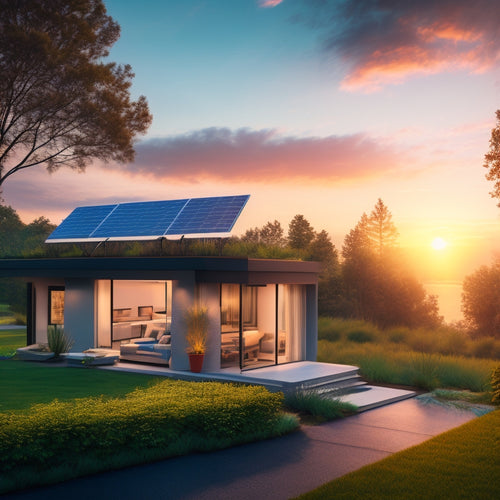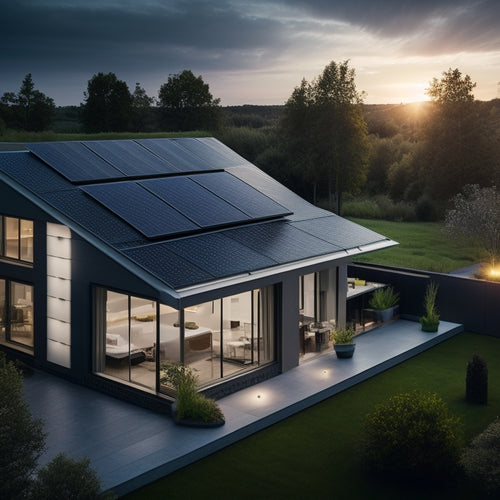
Solar Panels With Battery Back Up
Share
By integrating a solar panel system with a battery backup, you can achieve energy independence at night, storing excess daytime energy for nighttime use and maintaining a reliable electricity supply during dark hour outages. This setup allows you to power essential appliances after sunset, reducing your reliance on the grid. Advanced home power systems optimize energy consumption, guaranteeing power availability during evening hours. High-quality batteries, like Tesla Powerwall, enhance energy independence, and regular maintenance guarantees peak performance during dark hours. As you investigate the world of solar energy and storage, you'll uncover how to tailor your system to meet your specific energy needs and maximize your energy independence.
The Essentials
- Integrating a battery storage system with solar panels enables power generation at night, providing reliable electricity during dark hour outages.
- Battery backup systems store excess daytime energy for nighttime use, maintaining energy independence without reliance on the grid.
- Advanced home power systems optimize solar efficiency, while regular battery maintenance ensures peak performance during dark hours.
- High-quality batteries like Tesla Powerwall enhance energy consumption, providing power availability during evening hours and reducing reliance on the grid.
- Regular monitoring of battery health is crucial for reliability, ensuring freedom and autonomy in energy use during peak hours.
Energy Independence at Night
You're no longer limited to generating power during the day with solar panels and battery backup.
By integrating a battery storage system into your solar setup, you can unleash the full potential of renewable energy and create a more sustainable, dependable, and cost-effective power solution Energy Storage Solutions.
At night, you can draw on the stored energy to power your home, ensuring continuous operation of essential appliances.
This means you'll have power after sunset and during dark hour energy outages, providing a reliable source of electricity when you need it most.
Power After Sunset
As the sun sets, your solar panels' energy production comes to a halt, but that doesn't mean you have to sacrifice your energy independence.
With a battery backup system, you can store excess energy generated during the day for nighttime usage. This allows you to maintain your energy independence, even when the sun isn't shining.
By incorporating a high-quality house solar battery, such as the Tesla Powerwall, you can optimize your energy consumption and reduce your reliance on the grid.
A well-designed solar panel system with battery backup guarantees that you can still power your home during the evening hours.
Dark Hour Energy
The evening hours, typically considered the darkest regarding energy independence, can now be illuminated with the help of a solar panel system paired with a battery backup. This combination allows you to utilize the power of the sun during the day and store excess energy for use at night, guaranteeing a steady supply of electricity when you need it most.
With a battery backup, you can maintain your independence from the grid, even during peak evening hours. By leveraging advanced home power backup systems Renewable Energy Storage, you can enhance your solar efficiency and reduce your reliance on the grid.
To enhance your solar efficiency, it's crucial to maintain your battery's health through regular maintenance. This includes monitoring its state of charge, depth of discharge, and overall performance. By doing so, you can make certain your battery operates at peak levels, providing you with a reliable source of power during the dark hours.
With a well-maintained battery and a solar panel system, you can enjoy the freedom and autonomy that comes with being energy independent, even when the sun goes down.
Reduced Carbon Footprint
You're switching to a cleaner energy source with solar panels and battery backup, reducing your reliance on fossil fuels and mitigating climate change.
By utilizing renewable energy from the sun, you'll greatly decrease your carbon footprint.
With residential solar power systems, you can generate renewable energy and save on electricity bills.
This eco-friendly energy solution allows you to lower emissions now, contributing to a healthier environment for future generations.
Eco-Friendly Energy Source
Your shift to solar panels with battery backup greatly reduces your reliance on fossil fuels, slashing your carbon footprint in the process. This change to renewable energy not only benefits the environment but also aligns with your values of sustainable living. By utilizing the power of the sun, you're no longer dependent on finite resources, ensuring a cleaner and healthier planet for future generations.
| Energy Source | Carbon Emissions | Renewability |
| Fossil Fuels | High | Non-Renewable |
| Solar Energy | Low | Renewable |
| Nuclear Energy | Low | Non-Renewable |
With solar panels and battery backup, you're taking a significant step towards reducing your carbon footprint. By choosing this eco-friendly energy source, you're contributing to a cleaner environment and promoting sustainable living. This change is not only a personal victory but also an essential step towards creating a better future for our planet.
Lower Emissions Now
Carbon emissions plummet with the integration of solar panels and battery backup, greatly reducing your reliance on fossil fuels and slashing your carbon footprint.
This significant decrease in emissions is a vital step towards sustainable living, allowing you to minimize your impact on the environment. By utilizing renewable resources, you're no longer contributing to the pollution and climate change caused by traditional energy sources.
With solar panels and battery backup, you're generating clean energy and storing it for later use.
This means you're not only reducing your carbon footprint but also gaining energy independence. You're free from the constraints of the grid, and your energy needs are met without harming the planet.
Deep Cycle Battery Technology
You'll want to focus on two key aspects of deep cycle battery technology: battery cycle life and energy storage capacity.
When it comes to maximizing renewable energy storage, understanding these factors is essential in selecting the right deep cycle battery for your solar panel system.
Cycle life refers to the number of charge and discharge cycles a battery can handle before its capacity degrades, while energy storage capacity measures the amount of energy a battery can hold.
Understanding these factors is vital in selecting the right deep cycle battery for your solar panel system.
Battery Cycle Life
During the lifespan of a solar panel system, one significant aspect to contemplate is the battery cycle life, which greatly impacts the overall performance and reliability of the setup.
You'll want to guarantee your batteries are properly maintained to extend their lifespan. This involves monitoring charging efficiency, as excessive charging can reduce the battery's overall cycle life.
Temperature effects also play a considerable role, with extreme temperatures affecting discharge rates and overall performance.
To optimize usage, it's essential to understand your energy needs and adjust your consumption accordingly. Compatibility with your solar panel system is also critical, as mismatched components can lead to reduced efficiency.
When selecting batteries, consider cost considerations, warranty options, and the manufacturer's reputation for producing high-quality products.
Energy Storage Capacity
Capacity is the cornerstone of a reliable energy storage system, and deep cycle battery technology plays a crucial role in ensuring a steady power supply.
When you're evaluating energy storage capacity, you're fundamentally looking at how much power your battery can store and provide when you need it. You want a battery that can efficiently store excess energy generated by your solar panels during the day, so you can use it at night or during power outages.
Deep cycle battery technology is designed to maximize energy storage capacity while maintaining peak battery efficiency.
You'll want to examine factors like the battery's ampere-hour (Ah) rating, which measures its capacity to store electrical energy. A higher Ah rating generally means more energy storage capacity.
Additionally, look for batteries with high depth of discharge (DOD) ratings, which indicate how much of the battery's capacity can be safely used without damaging the battery.
Assess Your Energy Demands
You need to determine your daily energy consumption to properly size your solar panel system and battery backup.
This involves calculating your total watt-hours per day, factoring in your energy usage patterns, such as peak hours and standby modes.
For instance, you may want to reflect on investing in a home energy storage solution that can store excess energy generated by your solar panels for later use.
Daily Energy Consumption
Your household's daily energy consumption plays an essential role in determining the size and type of solar panel system with battery backup you need.
To accurately assess your energy demands, you'll need to understand your daily energy consumption patterns. This involves tracking your energy usage over a period of time to identify consumption trends.
Energy monitoring tools, such as smart meters or energy monitoring apps, can help you gather this data.
Energy Usage Patterns
Most households exhibit distinct energy usage patterns, with certain times of the day and year seeing considerably higher consumption than others. Understanding these patterns is essential for optimizing your energy efficiency and determining the right solar panel system with battery backup for your needs.
| Time of Day/Year | Energy Consumption Pattern |
|---|---|
| Morning (7-9 am) | Higher energy usage due to morning routines (lights, appliances, heating/cooling) |
| Afternoon (4-6 pm) | Peak energy usage from household appliances, HVAC, and lighting |
| Summer | Increased energy consumption from air conditioning and cooling systems |
| Winter | Higher energy usage from heating systems and holiday lighting |
| Weekends | Generally higher energy consumption due to increased occupancy and recreational activities |
Higher Surge Tolerance Capacity
You need a solar panel system with a higher surge tolerance capacity to protect your battery and other system components from power surges.
A higher surge tolerance capacity guarantees that your system can absorb sudden spikes in energy without sustaining damage.
This is especially vital for systems with high-power appliances that require a lot of energy to start up.
Power Surge Protection
Reliability is paramount in solar panel systems, especially when it comes to power surge protection. You want to guarantee that your system can withstand unexpected power surges that can damage your equipment and disrupt your energy supply. A higher surge tolerance capacity is essential in this regard.
When it comes to power surge protection, you need a system that can regulate voltage effectively. This is where voltage regulation comes in. Your solar panel system should be able to regulate voltage within a safe range to prevent damage from power surges. This is especially important when you're dealing with high-voltage systems.
A good power surge protection system should be able to detect and respond to power surges quickly. This can be achieved through the use of advanced surge protection devices that can detect surges and divert them safely to the ground.
You should also consider a system that has multiple layers of surge protection to guarantee that your equipment is fully protected. By investing in a reliable power surge protection system, you can enjoy uninterrupted energy supply and protect your investment from damage.
Frequently Asked Questions
Can I Add More Solar Panels to My Existing System Later?
You can expand your existing setup, but you'll need to ascertain system compatibility and consider installation factors, like roof space and electrical infrastructure, to seamlessly integrate new panels and maintain peak performance.
How Long Does It Take to Charge the Batteries Fully?
When you're off-grid, time is money; it takes 4-8 hours to fully charge your batteries, depending on charging efficiency and battery types, like lead-acid or lithium-ion, which drastically impact your energy independence.
Are Solar Panels With Battery Backup Noisy or Disruptive?
You'll find that most battery-based systems, in general, operate quietly, with minimal noise levels. When you add solar panels, the combo remains relatively quiet, with occasional sounds from the inverter or during battery maintenance, but overall, it's a peaceful, liberating experience.
Can I Use My Backup Power During a Grid Outage?
During a grid outage, you can utilize your backup power, ensuring uninterrupted freedom, by implementing effective power management strategies, which enable outage preparedness, allowing you to tap into your stored energy reserves and maintain control over your independence.
Are Solar Panels With Battery Backup Covered by Warranty?
When purchasing a backup system, you'll want to review the warranty coverage, ensuring it includes protection for the battery lifespan, typically ranging from 5-15 years, depending on the manufacturer and type of battery technology used.
Final Thoughts
As you utilize the power of solar panels with battery backup, you're not just generating electricity, you're unshackling yourself from the grid, much like Prometheus defying the gods to bring fire to humanity. With energy independence at night, a reduced carbon footprint, and advanced deep cycle battery technology, you're in control. By evaluating your energy demands and opting for higher surge tolerance capacity, you're illuminating a path towards a sustainable future. Now, bask in the radiance of self-sufficiency, free from the shackles of fossil fuels.
Related Posts
-

Top 10 Off Grid Camping Gear Must-Haves
When you're off-grid camping, the right gear is crucial for a smooth expedition. Start with a durable, weather-resist...
-

The Future of Residential Energy Storage
The future of residential energy storage looks promising and cost-effective for you. With lithium-ion battery prices ...
-

Home Solar Battery
You're opting for a home solar battery that allows you to utilize the power of the sun during the day and use it at n...


